I studied the rules of Age of Hannibal, created an army according to the AoH guidelines and used my Mons Graupius playtest scenario to played three Age of Hannibal Mons Graupius battles, and test the mechanics. Here’s the game data, battle setup and review.
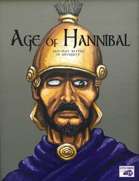
Game Data & Characteristics
Age of Hannibal, 2018, by Greg Wagman, is a 16$ 40-page PDF, core rules and extra supplement downloadable from Wargame Vault and the Little Wars TV-website. It’s meant to be a fastplay big battle wargame for 2-6 players, Greek/Roman era, with emphasis on the Punic wars. IGOUGO system. A base represents 500 cavalry or 750 infantry. The game is base-neutral, recommended is the standard 40mm basewidth, 40×40 bases, any scale. AoH is a historical variant of Chipco Fantasy Rules!. The author wanted to eliminate “the need for convoluted charts, excessive modifiers of tedious record-keeping, with a proper balance between playability and period flavor, while putting lots of miniatures on the table”. Game should last less than three hours.
Rulebook Quality
AoH was written/playtested by veteran historical wargamers who published their own version of the CFR! fantasy rules. Thus, the book gives a clear explanation of the game rules, while the historical background is assumed to be known. No long historical tales, jokes, or photographs. It’s functional. Players should do their own historical research.
The basic rules are 10 pages, 3 pages detail possible ‘Siege Warfare’, and the rest is appendices, with printable terrain cards, a simple army list, several example orders of battle and a 2-page quickref-sheet. The Punic battles are available in a separate 16$ publication.
Most text is clear. One subrule of the all-important Morale Clock (see below) was left open. I houseruled that. The general concepts are clear, too, although the difference between unit stats and dice roll modifiers via ‘traits/special abilities’ needed close reading. Overall clarity is good, same standard as other modern rulebooks.
Support is relatively low, in comparison with the AdlG, HC, DBA, of BKCIV, who have large forums. The Punic Wars supplement ($16) is the only supplement so far. LWTV has one video about terrain setup. You can ask questions however via their website, Gmail and Facebook.
The Game in Short
Nick the Lemming wrote in detail about AoH’s game mechanics. I will just summarize.
Type of game
AoH is an adaptation of the Chipco Fantasy Rules!. The ChFR! game is an element-based mass-battle game, similar to Hordes of the Things. I don’t know these original rules, but from reading reviews, it seems to take HotT as its starting point, but uses a d10 instead of a d6 to add more “granularity”. Basing, I understand, is in square elements, 40-60mm. More historical wargamers have used modded ChFR! rules for Ancient games.
Dice & Stands
AoH is played with ten-sided dice (eight-sided is optional) and stands (aka bases). Each base has just three basic statistics (Move, Combat, Rally) with an assortment of abilities and upgrades that affect certain aspects of battle. The ability (trait, upgrade) is a die roll modifier that can be lost during play (barbarians lose charge advantage after first charge). Abilities can make all the difference; a unit with Roman Drill, Veterans, Pila and Heavy Armour facing an enemy that is Inexperienced and Unreliable is going to have a field day.
Command & Control
Instead of a PIP roll (like in many DBA-variants) the player has a Morale Clock, a countdown PIP-clock: both sides start with 9 orders they can give to a max of 9 groups, but every time a side loses his round, it loses an order point. So the more often you lose your round, the more limited your choices will be. “You probably won’t be able to get all your army moving, certainly not in the later stage of the game as formations break up and the confusion of battle sinks in, since the current number on the morale clock denotes how many stands (or groups of stands) can be moved in the turn”. Nick the Lemming wrote. The first side who lost all Morale will lose the game.
Fog of War
Where is the enemy, and how will he attack? And when? AoH tries to bring more tension and unpredictability with a deck of cards with hidden terrain features and a few ‘stratagems’ (battle advantages like ‘ambush’ cards).
Flexibility
The unit types are limited (skirmishers, warband, blades, light/medium/heavy cavalry etc, think DBA) but players can upgrade/downgrade units with special traits (elite, or untrained, or tribal, or ranged weapons, etc). A player can for example split his 12-stand 4-stand barbarian warband in an ‘Elite’ warband with Gallic swordsman, and downgrade the other 8 to veterans, or even rookies, with throwing axes. In the appendix I found several template armies.
Gameplay
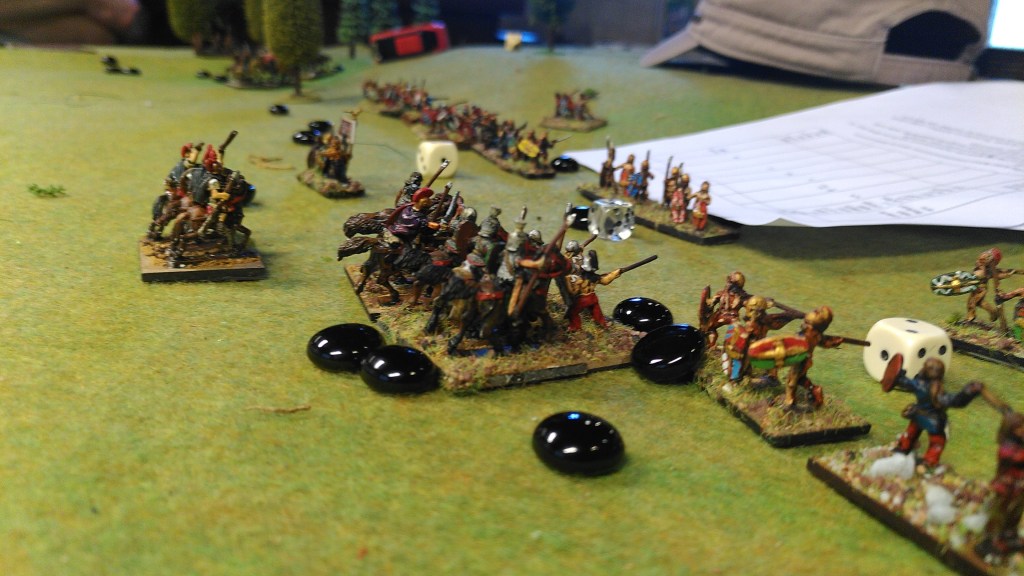
I played the game three times, every time the Mons Graupius standard scenario. I followed the recommended 750-men for an infantry base and 500 for a cavalry base.
The Two Opposing Armies (first playtest)
| Unit Name | # of bases | Unit Name | # of bases |
| Agricola – Commander in Chief – excellent tactician | CiC | Calgacus – Commander in Chief – fanatic warrior | CiC |
| Auxiliary Infantry (8000 men) – Open Order Heavy Infantry, well trained, steady, veterans, spear, sword, large shield | 11 bases | Chariots – (400 vehicles) – light 2-horse chariot, 1 unarmed driver & 1 warrior with javelins and shield, fast, impetuous, veterans | 1 base |
| Equites Alares (2 x 1500 men) – Heavy Cavalry, well trained, solid, veterans, javelins and shield | 6 bases | Skirmishers (2000 men) – light infantry, javelins, shield | 3 bases |
| Infantry in reserve: legionary Infantry (3000 men) – Close Order Heavy Infantry, well trained, solid, veterans, heavy throwing weapon, sword, large shield | 4 bases | Cavalry – mixed with skirmishers (2000 men) – light cavalry, impetuous, javelins and shield | 4 bases |
| Cavalry in reserve: Equites Alares (2 x 500 men) – Heavy cavalry, well trained, solid, veterans, javelins and shield | 2 bases | Warriors (20,000 men) – Open Order Medium Infantry, javelins, long sword, shield | 27 bases |
| Cavalry – on flanks (2 x 1000 men) – light cavalry, impetuous, javelins and shield | 4 bases | ||
| Aux Infantry/Heavy Cav/Reserve Infantry/Reserve Heavy Cavalry = AHI 11: HC 6: RHI 4: RHC 2 | 23 bases | Chariots/Skirmishers/Light Cavalry (center)/MI Warriors/Light Cavalry (flanks)= Ch 1: LI 3: LC 4: MI 27: LC 4 | 39 bases |
Next, I made the army stats.
Roman Army
| Unit Name | Type: Abilities (dice roll modifier) | Move (inch) | CF | RF | Support | Charge | Terrain | Cost | Total Cost |
|---|---|---|---|---|---|---|---|---|---|
| Commander Agricola | CiC: Noble Origins (+1RF), Veteran Soldier (+1CF) | 6/6 | +1 | +1 | 100 | 1×100 | |||
| Subcommander Cocacola | Lieutenant: Pious (1 Fate Reroll) | 6/6 | 100 | 1×100 | |||||
| Batavian Auxiliary Infantry | Hand Weapons: Pila (+2 first combat round), Roman Drill (Interpenetrate from Second Line) Veteran Combat (+1 Combat) | 4/3 | +3 | 6+ | Yes | 50 | 11×50=550 | ||
| Roman Flank Cavalry | Heavy Horse: Veteran Combat (+1 Combat) | 6/3 | +4 | 6+ | No | +1 | -2 | 55 | 6×55=330 |
| Roman Reserve Cavalry | Heavy Horse: Elite (+1 Combat, +1 Rally) | 6/3 | +4 | 6+ | No | +1 | -2 | 60 | 2×60=120 |
| Roman Legions | Hand Weapons: Pila (+2 first combat round), Roman Drill (Interpenetrate from Second Line), Elite (+1 Combat, +1 Rally) | 4/3 | +3 | 6 | Yes | 55 | 4×55=220 | ||
| Total Point Value | 1420 |
Caledonian Army (Unreliable)
| Unit Name | Type | Move (inch) | CF | RF | Support | Charge | Terrain | Cost | Total Cost |
|---|---|---|---|---|---|---|---|---|---|
| Commander Calgacus | Gifted Orator (+1 RF), Gambler (Reroll Combat for Fate Roll) | 6/6 | +1 | 100 | 1×100 | ||||
| Chariots | Chariots: Missiles (Thrown+1) | 8/3 | +2 | 6+ | No | +2 | -2 | 45 | 1×45=45 |
| Caledonian Javelins | Skirmishers: (Thrown+1), Free Facing | 5/4 | 6+ | No | 25 | 3×25=75 | |||
| Caledonian Light Cavalry | Light Horse: Missiles (Thrown+1 CF), Free Facing | 8/4 | 6+ | No | 45 | 8×45=360 | |||
| Caledonian Barbarians | Warband: Tribal (+1/+1 until DMZ), Wild Charge (+1 Charge, if win 2DMZ first turn) Impetuous | 5/4 | 5+ | Yes | +1 | 40 | 27×40=1080 | ||
| Total Point Value | 1660- (unreliable = 39×5=195) = 1465 |
Army Notes
- 23 bases Romans, 39 Caledonians
- To reflect the better Roman command and control, I gave the Romans an extra subcommander
- The auxiliaries were effective against the chariots and were put in front ‘to save Roman lives’. So I gave them veteran status and improved combat value, not morale
- The reserve cavalry was decisive and broke through the Caledonian line: similar to the legions, I gave them Elite status. Shock troops.
- British chariots had no scythes. They were fast skirmishers. Julius Caesar wrote about the British chariots:
“In chariot fighting the Britons begin by driving all over the field hurling javelins, and generally the terror inspired by the horses and the noise of the wheels are sufficient to throw their opponents’ ranks into disorder. Then, after making their way between the squadrons of their own cavalry, they jump down from the chariot and engage on foot. In the meantime their charioteers retire a short distance from the battle and place the chariots in such a position that their masters, if hard pressed by numbers, have an easy means of retreat to their own lines. Thus they combine the mobility of cavalry with the staying power of infantry; and by daily training and practice they attain such proficiency that even on a steep incline they are able to control the horses at full gallop, and to check and turn them in a moment. They can run along the chariot pole, stand on the yoke, and get back into the chariot as quick as lightning” (Gallic War, IV.33).
- The Caledonian army was apparently weak. So the javelins are skirmishers, not light infantry
- The Caledonian army collapsed. So I gave the whole army the ‘Unreliable‘ Trait, Rally test at Morale 5
- Equal points value, both 1420 vs 1465 points, a difference of one stand.
How Easy Is it to Compose an AoH Army?
The process is simple, but the choices were difficult. I struggled. Is the Roman cavalry in this scenario heavy cavalry, or medium cavalry? And the skirmishers, and the light horse: do they have ranged weapons, or thrown weapons? How will it work out? DBA, AdlG and ChFR! have army lists included. The AoH basic rulebook is ChFR! without army lists. It’s difficult to predict how an army list will work out and if it will result in a balanced game.
From Wargamevault I downloaded a free LibreOffice army composer stat sheet (not really convertible to MS-Excel).
Basic setup is as below: blue is Caledonians, red is Romans, cavalry on the flanks, two lines of infantry in the centre, the Caledonians have a chariot and skirmishers in the centre, the Romans a double line with elite cavalry and elite legionaries as reserve behind the auxiliaries.
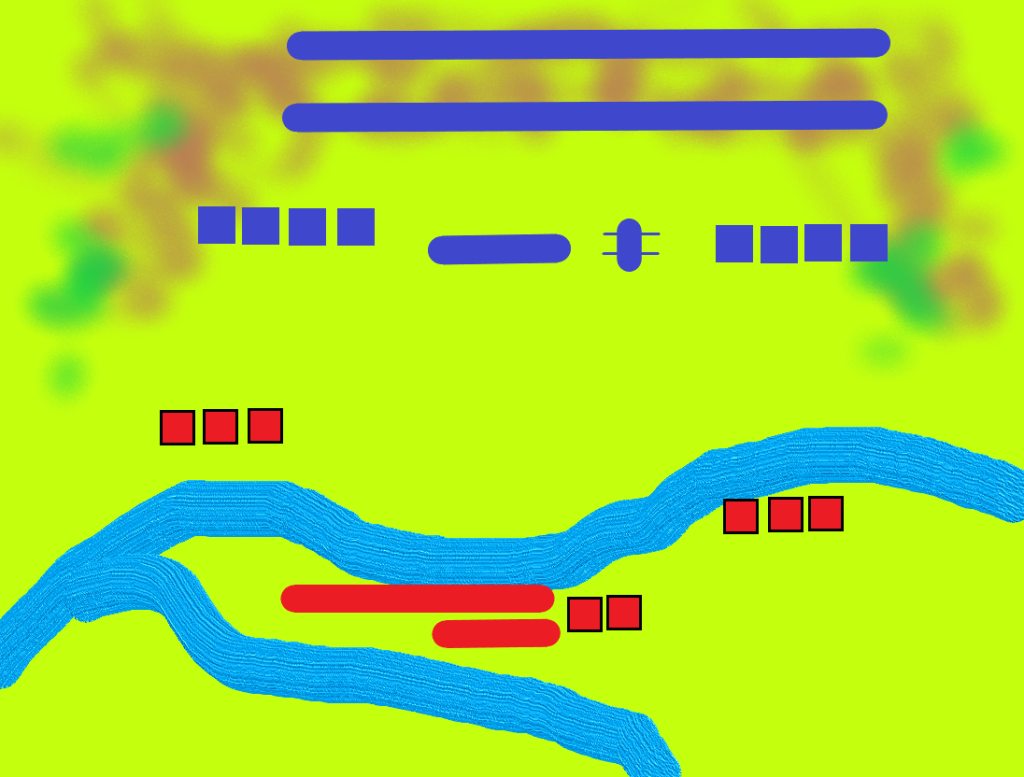
The First Playtest
With the armies above I played my first game against a club opponent, as Roman, and it was a carnage. Just like history, Roman heavy cavalry hammered the flanks while my superior infantry in the center withstood the Caledonian human wave. I lost the Roman lieutenant and a few cavalry bases, but overall the Caledonians stood no chance.
- as a historical replay, it was good, very, very Tacitus
- as a game, it was boring. The Caledonians quickly lost their bottle, although the points value of the armies was equal. Already after 2 turns we could predict their defeat.
- we easily understood the mechanics
- the ten-sided dice gave random results.
- Heavy Horse was unstoppable.
- Chariots were useless
- the Romans won while they had NO skirmishers
- Points values were equal, but the battle was one sided.
Impressions from others
After this first game, I researched the rules online to see if I had misunderstood something. On The Wargames Website I read the comment from player Autodidactosaurus (what a nickname!), who wrote:
As I suspected, using a D10 for combat can lead to extreme, unpredictable results though overall the combat between two equal armies seemed relatively balanced. Typical combats had bonuses of 2, 3 or occasionally more. But these pale when added to the random spread of 1 through 10.
The Command & Control Mechanics imply that maneuvering gets harder every turn and that C&C is easier when the army is smaller.
This player also commented:
“The morale clock which constrains the number of orders you can give seems rather ineffective when you start out with only 15 units. It was only on the last turn of the game when overall morale affected what the Gallic side could do. Even the extra demoralization markers handed out when the clock runs down didn’t have much affect on the game. By then, it didn’t really matter any way.
Forum participant A Lot Of Gaul replied:
“I think that most of the issues you discussed stem from the fact that your armies were so small. As you noted, Age of Hannibal works best with a large number of bases/units – the ‘sweet spot’ appears to be around 50-60 per side. With that number of units, the morale clock really shines, and the ‘extreme’ d10 rolls tend to average out much more. The optional d8 works very well to further reduce the possibility of ‘extreme’ die rolls, and that is in fact what I use in my games.”
It’s the combination of ten-sided dice and relative size of the army. Autodidactasaurus: “I also agree it’s the small number of units involved that causes Age of Hannibal results to be less than satisfying for me. If you’re using 50 units and lose a unit or two to ‘rangey’ dice, no big deal–what is that, 2%? 4%? There are plenty more chances for it to average out across the army. But if you only have 15 units in the army, losing two to a bad roll is 12% of the army! It doesn’t take too many losses like that to make you feel that the dice are ruling the game, not your strategy or the ‘historic’ strengths of the units.”
These comments are in line with the experience with the original ChFR! rules. A BoardGameGeek reviewer wrote:
I also have a few niggles with the game themselves. Combat uses D10s, introducing rather large result variance given the low combat factors, mostly in the 2-4 range. Flanking and support (overlapping the enemy line) only modifies this with +1, slightly undervaluing, in my view, good tactical placement. Hordes of the Things, with similar values but using a D6-based system is a bit more decisive in that respect (…) In general, the Command and Control aspect of the game is rather weak, mostly represented by the restraints imposed by the morale clock and the free activations given by leaders.
I should add that in the original Mons Graupius scenario the skirmishers and light horse are misplaced and that neither my opponent nor I had figured out how to use them effectively.
The Second and Third Playtest
I made changes:
- I downgraded the Heavy Cavalry to Medium Cavalry, as more appropriate for the 1st century and less invulnerable
- I gave the Caledonian chariot the ‘Fearsome’ an ‘Fast’ skill, and ‘Ranged Weapons’, as a kind of elite mobile gun.
- I downgraded the Roman subcommander to a ‘unproven’ subcommander, a free move for a group of three.
- I changed the Roman order of battle: 4 elite legionary units, 6 auxiliary units, 3 skirmish units and 2 bow units.
- The Caledonian points value was now a fourth (1670) than the Roman army (1230)
In the third playtest I used 8-sided dice instead of 10-sided. I played both games with experienced wargamers on a convention. I instructed the Caledonian chieftains to stay on the hill, as long as possible, to be smarter than their historical counterpart and make the best use of the terrain. In the second game the player followed that advice, in the third game the commander nevertheless attacked with his infantry force. In both games, however, the infantry was irrelevant. Cavalry decided the battle.
The free facing Light Horse
The rules say, about skirmishers and light horse: “Skirmishers and Light Horse are also the only unit types in the game rated as “Free Facing,” allowing them to move in any direction with their maximum movement.”
And this is how that works out.
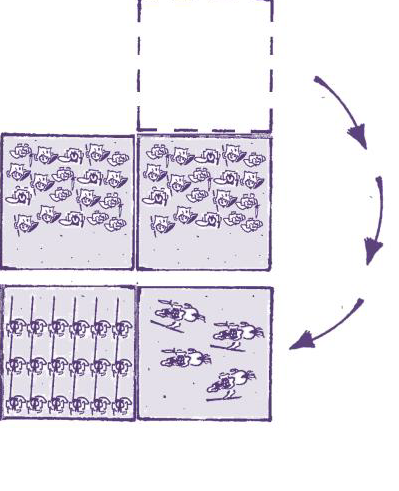
In other words, Light Horse can zigzag over the field and move in any direction during a turn. So if you have two swift Light Horse units, one unit can attack the front and the second one can attack the flank.
When hit by Light Horse in the flank or rear, the standard penalties are doubled, the rules say. “Watch out for Light Horse!”
And: if a unit is double demoralized and attacked in the flank, the unit is killed.
Bases don’t have a ‘threat zone’ so Light Horse can move around other bases.
In all three games the Caledonian player used his light horse to overwhelm the Roman cavalry.
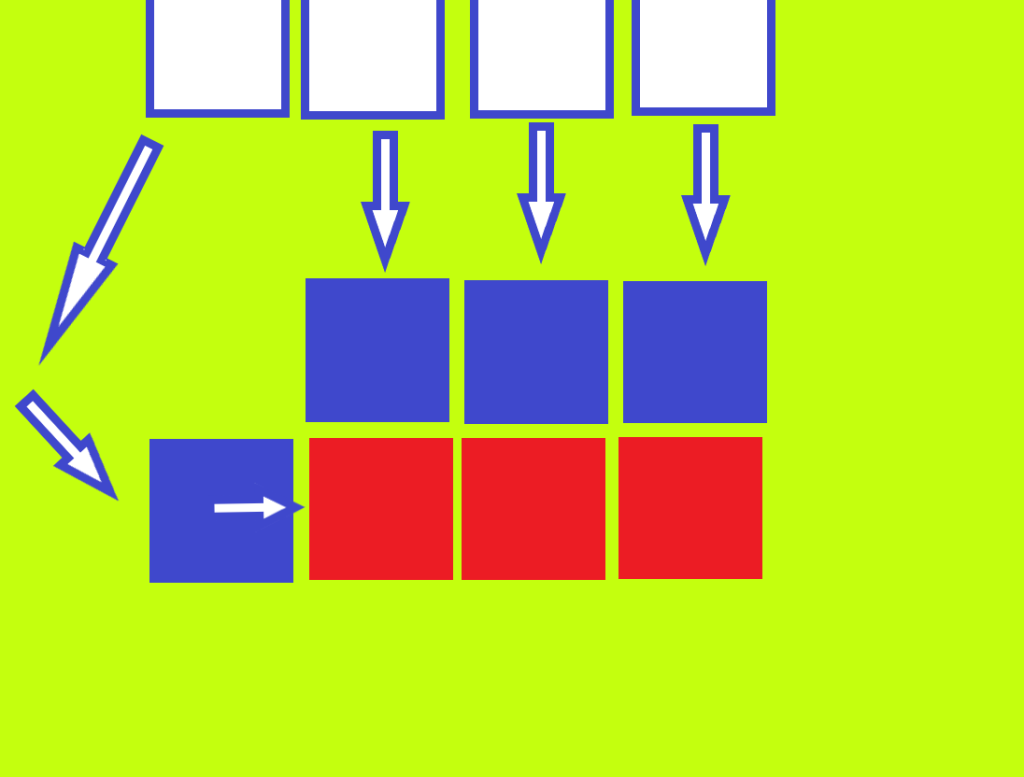
Against the heavy horse (+4 combat modifier and +1 when charging) during the first playtest this tactic damaged the Roman cavalry attack, the Romans lost a few units but were too strong and smashed the Caledonian Light Horse (+2 combat modifier) and later the Caledonian infantry.
Against Roman Medium Horse (+3 combat modifier, 2nd and 3rd playtest) however, the Caledonians ‘rolled up’ the Roman cavalry from the side. The Roman unit who is attacked in the flank sees his modifier decreased by -2 and with D10 combat becomes very random. If the Romans lose the flanked unit, the Caledonians can flank the next.
With D8 the results were less random, but still this tactic was effective.
So either the Roman cavalry was too strong, or too weak. Changing the stats of the cavalry effectively changed the whole game. I hadn’t expected that.
The armies moved in line formation. They can move faster in a three line column, but a column has a -2 combat modifier so that’s a great risk when attacked. Think again of fast moving Light Horse, that, again, could attack front and flank: a -4 modifier! Besides, the rules say that if a unit is forced to retreat (2nd demoralisation) and can’t retreat because of a friendly unit in the back, it’s destroyed. So columns are tactically dangerous.
Using D8 gave the problem that I still needed a D10 for the rally and ranged attack tables.
Conclusion
What I like:
- The rules look good, and are written in simple, plain English
- The rules force to to start decisive combat asap with a large group. Fast action! A player who waits too long will see his troops degraded by small skirmish flank attacks and ranged attacks, will lose rounds and as a consequence will lose Morale Points. If you’re losing it’s hard to turn the tide.
- I liked the ‘Pilum’ and ‘Roman drill’ traits. The Romans were known for their sustaining power, second line replacing the first, quincunx formation. Other rulesets neglect this ability, too difficult to model or not applicable for the unit scale.
- The rules are flexible. No army lists, but it’s not too difficult to make your own order of battle. Very customizable.
- I didn’t use the stratagems (random pre-battle tactical bonuses) and terrain generating rules, or the siege rules, but they appear to add some depth that other rules lack.
What I don’t like
- Balance. I think that the Punic supplement gives you balanced armies, but for other eras it might be a gamble how your army fights on a tabletop. Trial and error. That Punic supplement costs an extra $16, so for what is basically a Punic War ruleset without army lists for other eras you pay $32.
- Randomness. Relatively small modifiers with a D10 result in a quite random game, more random than, for example, DBA that has a D6 and a Quick Kill rule/rock-paper-scissors mechanic.
- Infantry skirmishers seem to have no other role apparently than being cannon fodder, slowing down the advancing enemy line. Or they are, together with Light Horse, the very dangerous flank attackers.
- The game is designed for 50-60 (square) bases per side. I don’t have so many, and what I have is based in DBx style.
- Lack of support. The writer and his YouTube channel and that’s it.
- Based on my own experience and interpretation, I’m unsure about the relative strength of Light, Medium and Heavy Horse in comparison to infantry. In all three games the early cavalry battles heavily influenced the outcome of the battle. Light horse is fast, hard to capture, and LH flank attacks might be the Death Star* of this game.
- My players complained that several aspects and concepts of the game were vague, compared to what they’re used to (DBx with very strict movement rules and interpretations).
Final Verdict
Two stars. Average. Age of Hannibal keeps it’s promise: it’s a simple and clear system for large (Punic) battles with small scale figures on (preferably) 40-60mm square bases: 2mm, 6mm, 10mm. It’s versatile, great to introduce newbies and I think it will work best for multiplayer battles with 50-60 bases on a regular table. It’s not an original system, and what I miss is army lists for other eras than the Punic wars. Not bad, but not really my cup of tea.
Comparison with De Bellis Antiquitatis, see my structured DBA-review: AoH is less balanced and more random, is liberal in movement and charging and but easier to grasp. AoH has less standard troop types, but comes instead with a list of characteristics, i.e. modifiers that you can assign to a unit. Positional and unit modifiers are more important in D6-DBA than in D10 of D8-AoH. AoH is Big Battle DBA-light.
What others think
Mellis1644 wrote on his Adventures in Painting Miniatures blog:
“We had a fun game and got to a conclusion in approx 3 hours of play with 40+ units on each side and 4 players – with us all learning the rules. That has to be said to be a success. (…) they are a fast play, not as formal version which give a decent game without too much fuss, especially for multi-player games. There is not a lot of differentiation between troop compared to some rules sets and that may be an issue for some. I also don’t think they would play as well for smaller games or competitive players – they are designed for big games and loads of toys on the table. (…) Their video’s help but there really does not seem much support for this rule set. I asked questions on their website and got no answers. There also is no forum etc for discussions (…) Another thing to be aware of is that the rules work for any basing but you can tell they really work better and are designed for square bases. Using DBX bases kind of works but left some oddness at times, especially when moving from line to column etc.
Well they play fast and for those used and like to the ADLG/DBA style games they are a fast play (…) That said there are some minor negative points with these rules. I have to say the production is definitely fan based. That goes to the rules writing style as well which is quite openly written. We had quite a few questions on aspects of the rules and some discussion on what they meant. Their video’s help but there really does not seem much support for this rule set. I asked questions on their website and got no answers.”
Nick the Lemming wrote:
“these rules. They’re compact rather than verbose, well-laid out, well-written with ease of use in mind, and with explanations for decisions made or examples of play throughout (…) the rules being easy to grasp, quick to learn, without too much looking up (we hardly checked the QRS after the first few turns, and seldom had to look stuff up in the book after the first time something new happened). It gave a satisfying game (…) Age of Hannibal made me want to get working on a Punic Wars campaign in particular (…) Support is probably the hardest to factor in (…) I reckon that (..) would be an A-, on the cusp of an A. There’s not that much Greg could have done to improve on this score. Very highly recommended indeed.”
My rating system: most wargame systems are ok: clear text and diagrams. Two stars. Some are below average: the system doesn’t work as promised, the game is (too) slow, the mechanics are tiresome, the publication is relatively expensive etc. One star. A few are really, really good: I rate these three stars.
*Death Star: a skill or unit that is an invincible super power
Warfare in the age of Cynics and Amateurs concluded, after a quick game:
“Simple but not simplistic, with a lot of drama, the set has great scope, particularly so if you are not an ancients expert and really just want a game rather than a complete historical re-enactment in this period. (…) A very nice set of rules. We didn’t have enough units to do it full justice today, but very easy to pick-up with some grander elements to master behind the simple mechanics. I love it…”

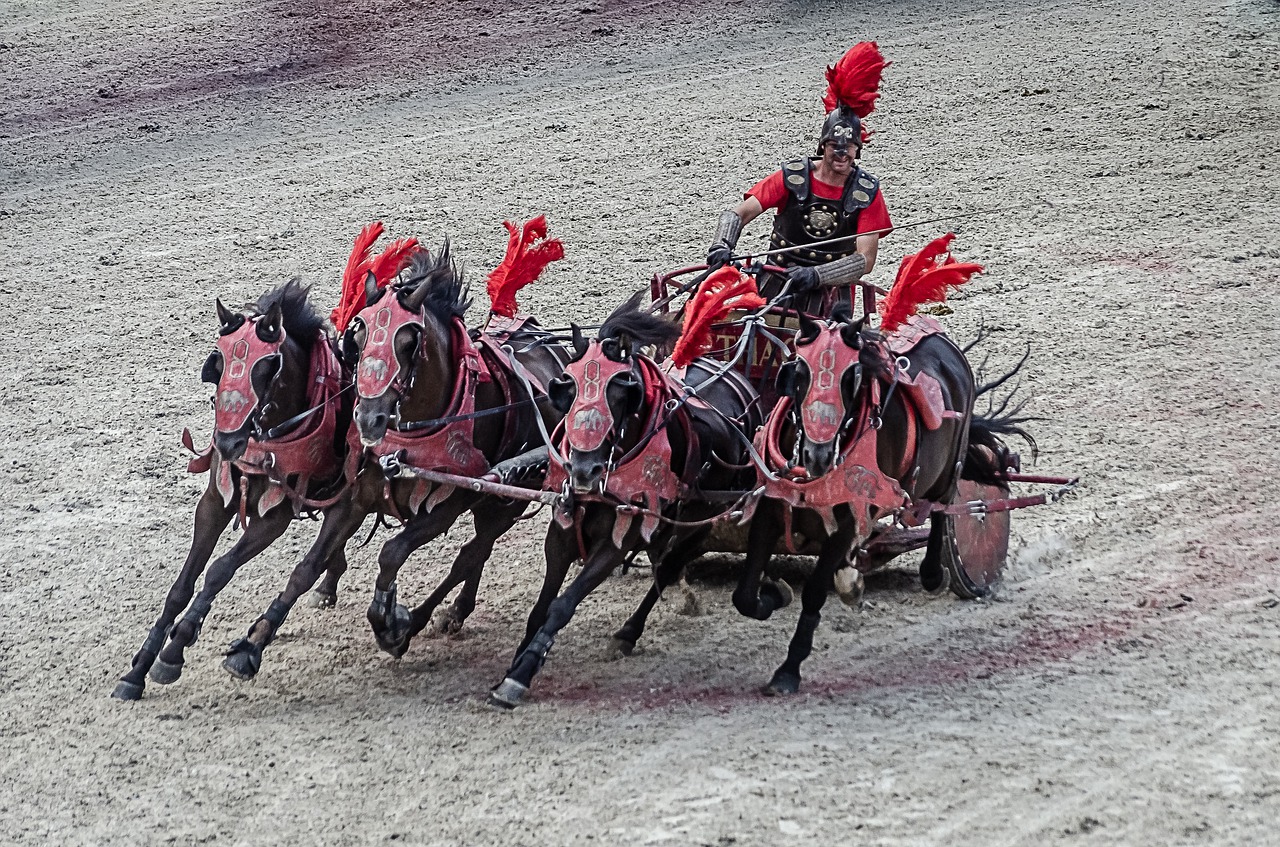
great review and playtests. I agree up to a point with your analysis. I think the rules have great scope for customisation and the morale clock is genius. You are right that there are a few open rules and army size can be an issue. Also super units cause more devastation on a smaller battlefield/army size. I have modded my set to be played with grids and do away with the free movement element and its harder to get those flank attacks in as a result. Also use of average dice is my preference to D10s
As a quick learn game for beginners its great, as a standalaone set for experienced gamers it needs work 🙂
LikeLike
A fantastic review of the rules and enjoying reading all of it. Hopefully you get the energy to do another set of rules the same way.
I don’t have the rules but have played the one it is based on – FR:TCE – a few times as ancient rules only. I liked the concepts in FR:TCE. There was a d8 Ancient fan written version of Fantasy Rules! 2nd edition but seemed to add in too many rules for me. I also played FR:TCE on a 2×2 and I think it may shine best on a small table rather than the 50-60 bases. I also think light Horse in FR:TCE were the same.
AoH sounds like a decent set of rules but I have so many I think I can stick with FR:TCE and not miss much.
LikeLike